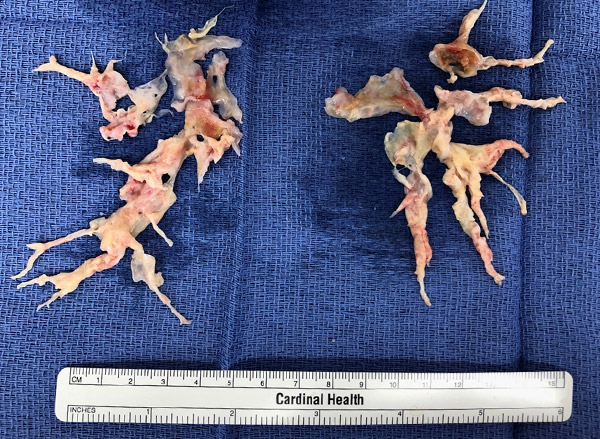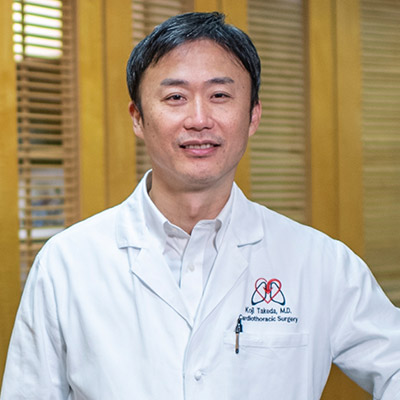For patients with chronic thromboembolic pulmonary hypertension (CTEPH), a rare condition in which a pulmonary embolism forms chronic clots and scar tissue in the pulmonary arteries, therapies are limited, quality of life is poor and disease progression is common. However, an innovative surgical approach offered at NewYork-Presbyterian/Columbia gives patients the potential for a cure.
Koji Takeda, MD, PhD
The procedure, called pulmonary thromboendarterectomy (PTE), is only available at specialized centers across the United States. Koji Takeda, MD, PhD, a cardiothoracic surgeon and Surgical Director of Heart Transplant and Mechanical Circulatory Support for the Division of Cardiothoracic Surgery at NewYork-Presbyterian/
“Pulmonary thromboendarterectomy is the only curative therapy for CTEPH,” says Dr. Takeda. PTE has been available at NewYork-Presbyterian/
CTEPH often starts as an acute pulmonary embolism that does not resolve with anticoagulation treatment. When the blood clot becomes chronic, it forms scar tissue that creates a blockage in the pulmonary arteries, leading to the hallmark symptom of CTEPH – shortness of breath.
“Typically, patients develop significant shortness of breath,” says Dr. Takeda. “The patient cannot walk even one block without tiring, and some patients require oxygen.”
CTEPH diagnosis involves several tests, including an echocardiogram and a pulmonary angiogram, as well as an assessment with a specialist in pulmonary hypertension. Since the symptoms can be confused with other conditions, such as heart failure, the diagnosis can be delayed. That is why it is critical to have a multidisciplinary team of specialists that can recognize the condition and develop a treatment plan, Dr. Takeda explains.
Pulmonary thromboendarterectomy is the only curative therapy for CTEPH.
— Dr. Koji Takeda
Dr. Takeda collaborates with both interventional cardiologists and pulmonary hypertension medical specialists at NewYork-Presbyterian/
A multidisciplinary approach helps to ensure a correct diagnosis and appropriate selection of patients for PTE. Some patients who are frail or have significant comorbidities, such as kidney failure, may not be good candidates for the extensive surgical procedure, says Dr. Takeda, who is also the Director of Pulmonary Endarterectomy at NewYork-Presbyterian/
Patients who are not considered good candidates for PTE may be treated with medical therapy and/or by the interventional cardiology team with a new technique called balloon pulmonary angioplasty, in which balloons are used to open blockages in the pulmonary arteries. Balloon pulmonary angioplasty may also be a good option for the 25% of CTEPH patients who experience recurrence after PTE.

A surgical sample showing the clot and scar tissue removed from a patient with CTEPH during PTE (Image courtesy of Dr. Takeda).
For patients considered healthy enough for surgery, PTE is an extensive operation that can take up to 10 hours. The chronic pulmonary clots and scar tissue tend to stick to the arterial wall and pulmonary artery bed, requiring special instruments to remove them, such as Madani forceps and Jamieson suction. Additionally, the procedure is complicated by the back flow of blood from the bronchial arteries. As a result, it is recommended that surgical PTE use deep hypothermia circulatory arrest to prevent the flow of blood from compromising the surgical field. Depending on the severity of the blockage, circulatory arrest can range from 15- to 30-minute intervals.
PTE surgery involves several steps, including:
- Median sternotomy
- Cardiopulmonary bypass
- Systemic cooling to 18-20 degrees Celsius
- Aortic cross clamping
- Circulatory arrest
- Thromboendarterectomy
- Rewarming of the patient
- Weaning the patient from bypass
PTE has been shown to significantly improve hemodynamic measures, such as systolic pulmonary arterial pressure, mean pulmonary arterial pressure, and pulmonary vascular resistance. This, in turn, provides an almost immediate improvement in patients’ symptoms. “It’s a dramatic transformation; the shortness of breath often disappears completely,” Dr. Takeda says.
The procedure also improves long-term outcomes, with a one-year survival rate of 92% and a five-year survival of 88%.
However, in-hospital mortality ranges from 3% to 5%. “It’s a high-risk procedure but it’s getting safer and safer,” Dr. Takeda says. He has been able to reduce mortality to 2%-3% in his PTE surgeries.
Making PTE safer involves “experience, a meticulous procedure, and the appropriate indication,” Dr. Takeda says. “We tailor each approach with the multidisciplinary team and ensure that the appropriate candidate goes on to surgery. If the patient is too high risk, we won’t attempt surgery.”
We tailor each approach with the multidisciplinary team and ensure that the appropriate candidate goes on to surgery.
— Dr. Koji Takeda
Dr. Takeda, Dr. Rosenzweig, and their colleagues at NewYork-Presbyterian/
In a separate study, published in the Journal of Thoracic and Cardiovascular Surgery, they analyzed the significance of right heart remodeling and tricuspid regurgitation on patient outcomes following PTE. They found that PTE was linked to improvements in right heart remodeling, but that residual tricuspid regurgitation was associated with worse patient outcomes and so should be closed watched following surgery.
The complexity of determining which patients are likely not only to survive surgery, but to experience good long-term outcomes, drives home the need for treatment at specialized centers that utilize multispecialty teams. “This condition requires a comprehensive approach of medical specialists, surgeons, and interventionalists. Patients should be evaluated by the full team of specialists,” Dr. Takeda says.




